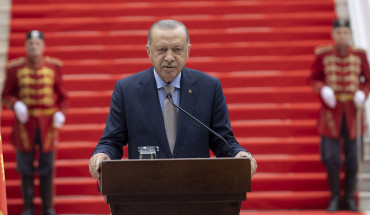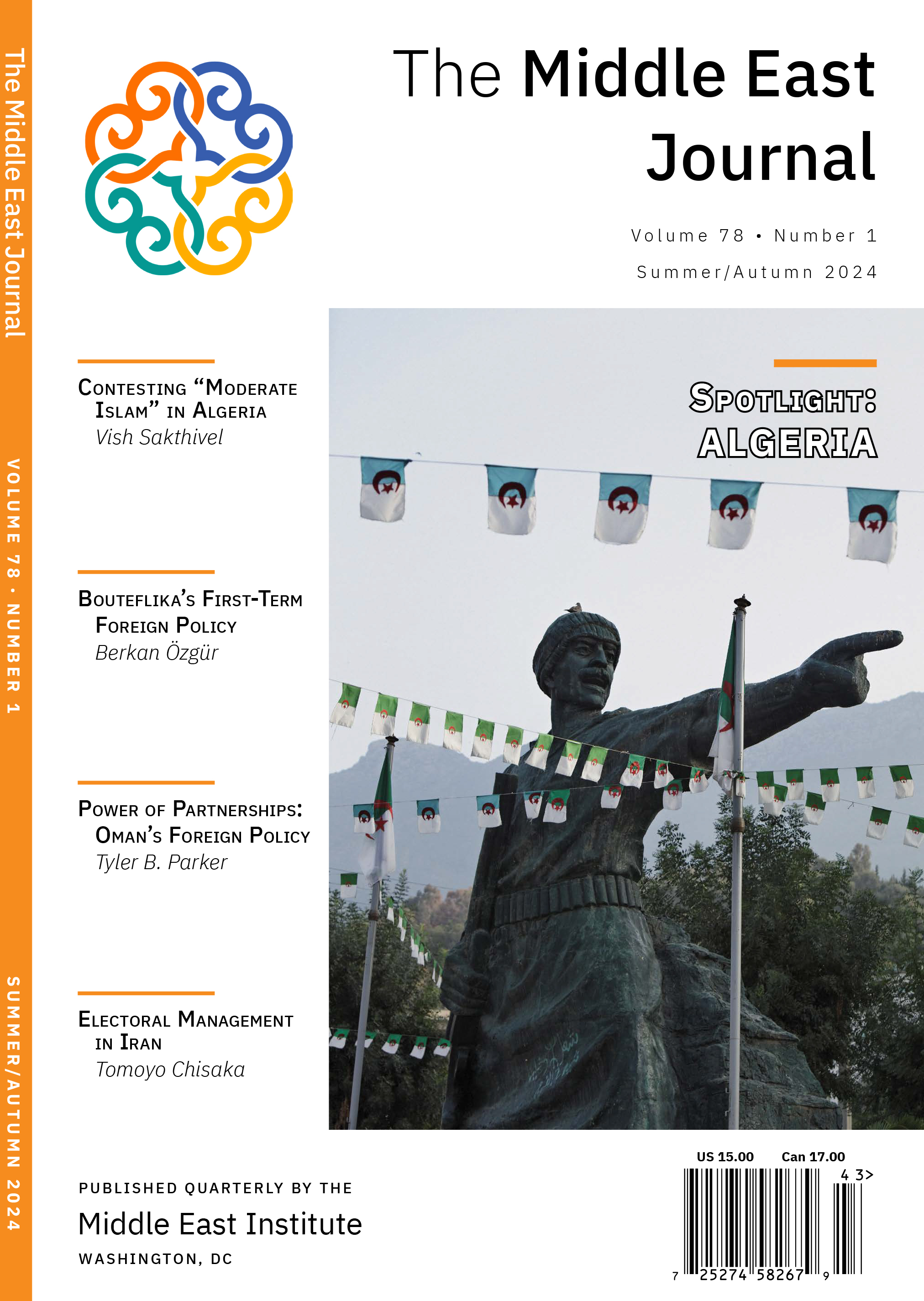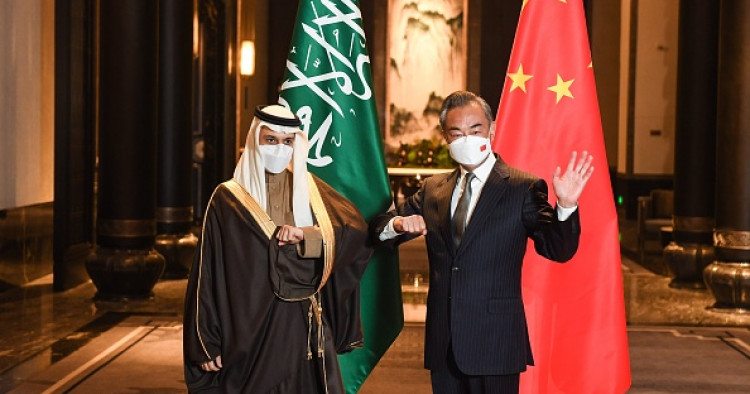This piece is part of the series “All About China”—a journey into the history and diverse culture of China through short articles that shed light on the lasting imprint of China’s past encounters with the Islamic world as well as an exploration of the increasingly vibrant and complex dynamics of contemporary Sino-Middle Eastern relations. Read more ...
The UAE’s freezing of the F-35 fighter jet deal reveals the changing views in the Arab Gulf region vis-à-vis the US’ current and possible future role there.[1] The scrubbing of the deal came after Abu Dhabi signed an alternative deal to acquire French Rafale fighters.[2] This move also followed a debate in the Congress and the White House over China’s possible exploitation of its close relations with Abu Dhabi to obtain manufacturing secrets for the most advanced fighters in the US military arsenal.[3]
As for Saudi Arabia, CNN reporting based on US intelligence reports from December 2021 disclosed that Riyadh is developing ballistic missiles with China’s help and manufacturing them at a site in the Kingdom revealed by satellite images.[4] The Kingdom had also purchased Chinese ballistic missiles in 2019. additional information concerning Sino- cooperation between China and the Gulf states in nuclear energy, surveillance technology, 5G networks, and artificial intelligence (AI).
The US is monitoring these developments with great concern, as American decision-makers and pundits have recently classified China as Washington’s top adversary and the main threat to its global standing. Washington is exerting increased pressure on its allies throughout the world to limit its collaboration with the PRC as part of its policy to counter China on multiple fronts and prevail in the ongoing strategic competition [5]
Arab Gulf leaders have begun to pursue policies to respond to the rise of China and the receding power and influence of the United States. It can be argued that the Arab Gulf states in general, particularly Saudi Arabia and the UAE, regard US concerns over China’s ascent as an opportunity to bargain with Washington and realize some military and technical gains. The polarization between Washington and China gives them wide berth to maneuver and extract benefits from both sides without the Gulf states having to take drastic steps in terms of its cooperation with China.[6]
Return to Cold War Policies
US pressure on countries to limit their cooperation with China signals a return to the geostrategic competition that prevailed during the Cold War. The formation of the AUKUS alliance between the US, the UK, and Australia on September 15, 2021, underscores Washington’s policy of countering China in the Indo-Pacific. The alliance is focused on developing an extensive network of intelligence-exchange arrangements, strengthened military/technical cooperation, and technology transfer between the member states across the Indo-Pacific.[7]
There is a consensus among decision-makers in Washington that China is the top threat to American national security, given its rapid technological progress and central position in the global economic system, supply chains, and international trade. There is also general agreement that China is determined to reshape the international system through global projects such as the Belt and Road Initiative (BRI).[8]
These concerns have led the United States to adopt policies that seek to blunt China’s efforts to achieve superiority in advanced technological fields, such as artificial intelligence (AI), 5G networks, and big-data analysis. Featured among such policies are restrictions on American technology companies that specialize in manufacturing semi-conductors, processors, software, and operating systems to prevent them from dealing with China.
In this context, Washington has narrowed its focus on cases of Chinese industrial spying on American technology companies, academic circles, and American military bases. This is pushing Washington to block the spread of Chinese 5G networks in allied countries that host US military bases to prevent potential Chinese spying on the operating systems at these bases.[9]
Despite ongoing negotiations between the Biden administration and China to manage the tensions between the two countries, the trade war between them continues to rage. In this regard, China is threatening to use rare earth exports and exert pressure on American companies operating in China to counter America’s escalation against China. Such escalation includes the US’ restrictions on Chinese exports and its halting of cooperation between American technology companies and their Chinese counterparts.
Nascent Militarization of China-Gulf Relations and US Security Concerns
Heightened American concerns about, and strong efforts to respond to China’s increasing capabilities and ambitions have recently turned to the Gulf, where the US has been the predominant external actor and served as security guarantor for the past half century. In the context of intensifying US-China global strategic competition, Washington ever more wary of the security implications of China’s increasingly extensive ties with the Gulf States. For example, one of the US objections to the sale of F-35 fighters to the UAE reportedly was the concern that China might acquire access to sensitive US military technology, especially given the growing technical cooperation between China and the UAE.[10]
In fact, cooperation between China and the UAE is being closely scrutinized by US intelligence and national security institutions. For example, the Intelligence Authorization Act (IAA 2022) drafted in October 2021 called for the Director of National Intelligence (DNI), Avril Haines, to submit a report within two months on Chinese-Emirati cooperation in strategic sectors and the potential for transferring sensitive American technology to China via Abu Dhabi.[11]
Broader US concerns about China’ inroads in the MENA region center on the possibility that new forms of Sino-Middle East cooperation might develop that combine Israeli technologies, Emirati and Saudi funding, and Chinese infrastructure, ultimately placing American interests at risk. Stoking such fears in some circles in Washington have been the activities of Group 42, which manages the projects of Sheikh Tahnoun bin Zayed and directs many partnerships with China in vital areas (e.g., vaccine manufacturing and big-data analysis) and has ties with Israeli data-analysis companies.[12]
US concerns about the security implications of China’s expanding role in the Gulf are not unfounded. Following decades during which Chinese activities in the region were narrowly focused on economic and technical cooperation, they have come to encompass military-security affairs. Indeed, China’s profile in the Gulf military-security sphere has gradually increased, in the areas of arms sales, weapons manufacturing, military exercises, and possibly arrangements regarding construction of military and/or intelligence-gathering installations.
Washington’s concerns peaked in November 2021, after The Wall Street Journal revealed that China was building a military base in the UAE, just hours before US Defense Secretary Lloyd Austin began his tour of the Gulf states. In the spring of 2021, US intelligence observed that China was secretly building a military site at Khalifa Port near Abu Dhabi. The newspaper’s sources suggested that construction had stopped only after US pressure went so far as to threaten an end to the F-35 deal.[13]
After this report was published, Abu Dhabi was quick to assure that the facility was not a military facility. During his talk at the Arab Gulf States Institute in Washington last December, Dr. Anwar Gargash, a diplomatic adviser to the president of the UAE, noted that the UAE “stopped the work on the facilities. But our position remains the same, that these facilities were not really military facilities.” He added that the UAE takes its allies’ concerns (here referring to the US) into consideration.[14]
Thoughts on building a military base in the Gulf is also an exceptional development in Chinese policy vis-à-vis the Middle East. For decades, Beijing has adhered to a policy of non-alliance with any power in order to avoid becoming embroiled in costly defense commitments that would affect its interests. To that end, China maintains simultaneous partnership relations with Iran and Middle Eastern countries, seeking to remain free from alliances and obligations to defend another’s interests. Instead, China focuses on strengthening economic cooperation with partners and employing mutual relationships to support its own political interests and push countries to adopt positions aligned with these interests.[15]
China has long sought to avoid deploying large military forces outside its own territory, specifically the South China Sea and its immediate neighborhood. The only exception to this is its military base in Djibouti, which carries out anti-piracy missions. Otherwise, China does not maintain any declared military bases, though rumors abound of another military base at Gwadar Port in Pakistan. Previously, Beijing was content with its partnership agreements and strategic partnerships with the Gulf countries, which focus on economic, commercial, and technological relations.[16]
Chinese arms exports to Middle Eastern nations have also grown,[17] with some estimates indicating that between 2016 and 2020 China increased the volume of its arms exports to Saudi Arabia have increased from $35 million in the period between 2011 and 2015 to $170 million in 2016 – 2020. The same applies to the exports to UAE, which increased from $45 million to $121 million during the same periods.[18] These values cannot compare to the huge sums dedicated to importing US arms, but they could hint at an increasing military cooperation between China and the UAE.
There are also estimates that China was among the five largest arms-suppliers to Qatar during the period between 2000 and 2019.[19] Much of this increase in Chinese military exports to Qatar occurred during a period of strained relations between UAE and KSA, and so these sales may be seen as political leverage over China rather than a paradigm shift in the regional balance of power.
Although China’s share of the arms supplied to Gulf states remains tiny compared to that of other traditional weapons sources, these numbers demonstrate Beijing’s aspirations for strengthening its military relationships with Gulf states. In the coming years, China may exploit ongoing regional transformations, amid Washington’s move toward minimizing its involvement and clashes with regional issues, to expand its arms sales to Gulf states.
Chinese arms sales to Gulf states are not limited by any political stipulations concerning democracy and human rights. China’s arms sales policy also allows for the export of important, high-quality weapons such as drones, which make up a significant proportion of its arms sales to Gulf states in recent years. Saudi Arabia has bought several Chinese drones, like the CH-4 and the Wing Loong II, especially since 2014. In March 2017, China announced that Saudi Arabia was interested in purchasing up to 300 Wing Loong II drones.[20] Furthermore, in November 2019, reports indicated that China was negotiating with Saudi Arabia to sell it the Blowfish A3, an unmanned helicopter equipped with an automatic weapon capable of using AI to target individuals.[21]
In 2011, the UAE also acquired at least five Wing Loong I drones from China. Moreover, the UAE showed great interest in obtaining Wing Loong II drones and received its first shipment of these aircraft in 2017. The Wing Loong II is considered an advanced weapon, as it can carry up to 12 weapons and possesses a high-performance engine as well as state-of-the-art avionics and sensors.[22] It should also be noted that, in recent years, China has supplied Qatar with the SY-400 short-range ballistic missile system, which has a 400-km range and is one of China’s most important military sales to Qatar.[23]
At another level, China plays an important role in the development of Gulf military manufacturing. In March 2017, on the sidelines of Saudi King Salman bin Abdulaziz’s visit to China, the King Abdulaziz City for Science and Technology announced that its president and the chairman of China Aerospace Science and Technology Corp. had signed a partnership agreement to manufacture drones. At the same time, the CEO of Saudi Air Navigation Services, a company affiliated with the Saudi Technology Development and Investment Company, announced the signing of an agreement with China Aerospace Long-March International Co. (ALIT) to manufacture drones in Saudi Arabia. He noted that the production of Saudi drones would be for military and civilian purposes, and that they would be marketed to other countries in the region.[24]
China’s efforts to help develop Gulf military industries did not stop with signing this agreement with Saudi Arabia in March 2017. Last December, reports based on US intelligence sources noted that Saudi Arabia is developing ballistic missiles with China’s help. As these reports explained, “Satellite images…suggest the Kingdom is currently manufacturing the weapons in at least one location.”[25]
Indications of a military industry partnership also appeared in relations between China and the UAE. In 2019, the creation of the China-Emirates Science and Technology Innovation Laboratory (CEST) was announced, which includes the transfer of Chinese drone technology to the UAE. The laboratory is located in an Abu Dhabi industrial complex owned by the International Golden Group (IGG), which is partially owned by the UAE Tawazun fund. Signs of military manufacturing cooperation between the UAE and China were also evident during the Dubai Air Show held in November 2021, where IGG showcased an intelligence attack drone, the Golden Eagle, made by China’s Norinco.[26]
The possibility of developing new modes of Chinese-Gulf cooperation in the field of military exercises has also emerged in recent years. Perhaps the most prominent example of this is found in Saudi-Chinese relations. For example, in October 2016, special forces units of the Saudi Royal Land Forces participated in “Exploration 2016,” held in Chongqing, China, which focused on enhancing the capabilities of Saudi and Chinese forces to combat terrorism and non-traditional security threats.[27]
Similarly, in November 2019, King Faisal Naval Base in Saudi Arabia hosted the “Blue Sword 2019” military exercises with the Saudi navy and its Chinese naval counterparts. According to statements from the Saudi side, the exercises aimed at “building mutual trust, promoting cooperation between Saudi and Chinese naval forces, exchanging expertise, developing participants’ capabilities through drills in naval terrorism and piracy, and raising the level of training and combat readiness.”[28]
Greater Leeway for Gulf Maneuvering
During his visit to China in July 2019, Crown Prince Mohamed bin Zayed of Abu Dhabi, confirmed that the foundations of Chinese-Emirati relations had been laid for the next 100 years. This means that cooperation with China will represent a key pillar in Gulf state foreign policy during the coming “Asian century.”[29] Highly-diversified relations have come to encompass several fields, such as vaccine development, AI, drone technology, 5G networks, port development, and future energy. These issues have numerous civilian and military applications that sweeten the deal for a strategic partnership with China, which undoubtedly has raised US concerns.
It seems that American concerns over the growth of strategic cooperation between China and the Arab Gulf states are being used as leverage against the US to consider the region’s interests as it makes new arrangements for its role in the region. Such considerations include whether to withdraw from conflict hotspots, negotiate with Iran, insist on spreading democracy, or focus on human rights issues.
The militarization of these relations underscores the mutual inclinations shared between China and some Gulf states, primarily the UAE, to go beyond the scope of economic and technological cooperation and pursue military arrangements. All of this comes on the heels of Washington’s latest steps toward reducing its military commitments to its Middle Eastern allies and its rapid withdrawal from Afghanistan. The Gulf states want to transcend their exclusive military cooperation with Washington and bolster relations with other powers, especially China, which will ultimately determine who emerges as the region’s next partner in the era following the US’ departure.
Furthermore, American threats to use the Countering America’s Adversaries Through Sanctions Act (CAATSA) have become less severe after Turkey was able to maneuver around Washington and broker the S-400 deal with Russia with minimal sanctions. India was also able to portray its import of weapons from Russia as a guarantee of regional security in South Asia to confront Chinese influence.[30]
These trends are also justified by the conviction prevalent in some Gulf states, especially Saudi Arabia and the UAE, that relations with geostrategic competitors put them in an advantageous position. In this way, the two powers compete for influence and devote greater attention to the ally state in their pursuit of hegemony through financial, political, and economic incentives. This was previously not possible when Washington was directly involved in the region, protecting its influence, and confronting international attempts to penetrate the Gulf.
Conclusion
Relations between the US and its Gulf allies are now governed by mutual doubts over intentions, commitments, ongoing haggling over what each can offer the other, alternative options, and their respective bargaining chips. Undoubtedly, China’s presence in the equation expands the Gulf states’ room to maneuver in their relations with Washington and puts them in a stronger negotiating position. However, this position does not come without a cost, as the Gulf states also harbor their own suspicions regarding China’s close strategic relationship with Iran.
[1] UAE told the U.S. it will suspend talks on F-35 jets -Emirati official,” Reuters, December 15, 2021, available at: https://www.reuters.com/business/aerospace-defense/uae-threatens-pull-out-23-bln-f-35-drone-deal-with-us-wsj-2021-12-14/.
[2] Chyrine Mezher, “The UAE is buying the French Rafale. What does it mean for the F-35?” Breaking Defense, December 8, 2021, https://breakingdefense.com/2021/12/the-uae-is-buying-the-french-rafale-what-does-it-mean-for-the-f-35/.
[3] Warren P. Strobe and Nancy A. Youssef, “F-35 Sale to U.A.E. Imperiled Over U.S. Concerns About Ties to China,” The Wall Street Journal, May 25, 2021, https://www.wsj.com/articles/f-35-sale-to-u-a-e-imperiled-over-u-s-concerns-about-ties-to-china-11621949050.
[4] Zachary Cohen, “CNN Exclusive: US intel and satellite images show Saudi Arabia is now building its own ballistic missiles with help of China,” CNN, December 23, 2021, https://edition.cnn.com/2021/12/23/politics/saudi-ballistic-missiles-china/index.html.
[5] White House, “Interim National Security Strategic Guidance,” March 2021, https://www.whitehouse.gov/wp-content/uploads/2021/03/NSC-1v2.pdf.
[6] Mohammed Soliman, “The coming US-China cold war: The view from the Gulf,” Middle East Institute, March 15, 2021, https://www.mei.edu/publications/coming-us-china-cold-war-view-gulf.
[7] Bonnie Girard, “China’s AUKUS Response Highlights Beijing’s Bunker Mentality,” The Diplomat, September 30, 2021, https://thediplomat.com/2021/10/chinas-aukus-response-highlights-beijings-bunker-mentality/.
[8] Keegan Elmer, “China is United States’ top security threat, defence official tells Aspen forum,” South China Morning Post, July 19, 2019, https://www.scmp.com/news/china/politics/article/3019487/china-united-states-top-security-threat-defence-official-tells.
[9] For more information about US. Assessment of Chinese technological threat, see: Office of the Secretary of Defense“Military and Security Developments Involving the People’s Republic of China: A Report to Congress,” November 3, 2021, https://media.defense.gov/2021/Nov/03/2002885874/-1/-1/0/2021-CMPR-FINAL.PDF.
[10] Strobe and Youssef, “F-35 Sale to U.A.E. Imperiled Over U.S. Concerns About Ties to China.”
[11] “Washington concerned about joint Chinese-Emirati push into Europe,” Intelligence Online, October 12, 2021, https://www.intelligenceonline.com/government-intelligence/2021/10/12/washington-concerned-about-joint-chinese-emirati-push-into-europe,109698004-art.
[12] “US wary as China and UAE lean into security cooperation,” Intelligence Online, June 15, 2021, https://www.intelligenceonline.com/government-intelligence/2021/06/15/us-wary-as-china-and-uae-lean-into-security-cooperation,109673309-art.
[13] Gordon Lubold and Warren P. Strobel, “Secret Chinese Port Project in Persian Gulf Rattles U.S. Relations with U.A.E,” The Wall Street Journal, November 19, 2021, https://www.wsj.com/articles/us-china-uae-military-11637274224.
[14] Warren P. Strobel, “U.A.E. Shut Down China Facility Under U.S. Pressure, Emirates Says,” The Wall Street Journal, December 9, 2021, https://www.wsj.com/articles/u-a-e-confirms-it-halted-work-on-secret-chinese-port-project-after-pressure-from-u-s-11639070894.
[15] Jonathan Fulton, “China between Iran and the Gulf Monarchies,” Middle East Policy, December 2021, DOI: 10.1111/mepo.12589.
[16] Ibid.
[17] Alvite Ningthoujam, “The Middle East: An Emerging Market for Chinese Arms Exports,” The Diplomat, June 25, 2021, https://thediplomat.com/2021/06/the-middle-east-an-emerging-market-for-chinese-arms-exports/
[18] “SIPRI Trend Indicator Values (TIVs),” Stockholm International Peace Research Institute, 2021, https://armstrade.sipri.org/armstrade/page/values.php.
[19] US Congressional Research Service, “Arms Sales in the Middle East: Trends and Analytical Perspectives for U.S. Policy,” November 23, 2020, https://sgp.fas.org/crs/mideast/R44984.pdf.
[20] Franz-Stefan Gady, “China, Pakistan to Co-Produce 48 Strike-Capable Wing Loong II Drones,” The Diplomat, October 9, 2018, https://thediplomat.com/2018/10/china-pakistan-to-co-produce-48-strike-capable-wing-loong-ii-drones/.
[21] Jon Lockett, “Robo Killers: China selling deadly AI ‘Blowfish’ drones that decide who lives and who dies to Middle East war zones,” The Sun, November 13, 2021, https://www.thesun.co.uk/news/10341241/china-blowfish-drones-middle-east/.
[22] Ningthoujam, “The Middle East: An Emerging Market for Chinese Arms Exports.”
[23] Mordechai Chaziza, “China–Qatar Strategic Partnership and the Realization of One Belt, One Road Initiative,” China Report 56, 1 (February 2020).
[24] Christopher Diamond, “China to open a drone factory in Saudi Arabia,” Defense News, March 29, 2017, https://www.defensenews.com/air/2017/03/28/china-to-open-a-drone-factory-in-saudi-arabia/.
[25] Zachary Cohen, “CNN Exclusive: US intel and satellite images show Saudi Arabia is now building its own ballistic missiles with help of China,” CNN, December 23, 2021, https://edition.cnn.com/2021/12/23/politics/saudi-ballistic-missiles-china/index.html.
[26] “China and UAE flaunt partnership at Dubai Air Show,” Intelligence Online, November 23, 2021, https://www.intelligenceonline.com/international-dealmaking/2021/11/23/china-and-uae-flaunt-partnership-at-dubai-air-show,109706647-eve.
[27] “China holds first anti-terror drills with Saudi Arabia,” Reuters, October 27, 2016, https://www.reuters.com/article/us-china-saudi-security-idUSKCN12R0FD.
[28] “Saudi, Chinese Navies Conclude Blue Sword 2019 Drill,” Asharq Al-Awsat, December 5, 2019, https://english.aawsat.com//home/article/2022166/saudi-chinese-navies-conclude-blue-sword-2019-drill.
[29] “Sheikh Mohamed: UAE and China creating 100-year 'road map' to boost alliance,” The National, July 31, 2019, https://www.thenationalnews.com/uae/government/sheikh-mohamed-uae-and-china-creating-100-year-road-map-to-boost-alliance-1.889755.
[30] Mukesh Aghi and Vikram Mahajan, “The Problem With CAATSA,” The Diplomat, December 17, 2021, https://thediplomat.com/2021/12/the-problem-with-caatsa/.
The Middle East Institute (MEI) is an independent, non-partisan, non-for-profit, educational organization. It does not engage in advocacy and its scholars’ opinions are their own. MEI welcomes financial donations, but retains sole editorial control over its work and its publications reflect only the authors’ views. For a listing of MEI donors, please click here.












